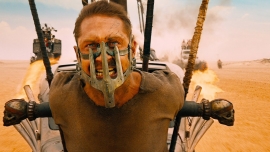"If I think about the future of cinema as art, I shiver" (Y. Ozu, 1959)
DICK MILLER
Wednesday, 05 February 2020 22:23John Mariner
There are some faces that remain themselves for life. Faces beyond the films in which they appeared. Faces that resist the gaze of Roger Corman, Joe Dante, Jonathan Demme, Robert Aldrich, Phil Karlson, Jonathan Kaplan, Steven Spielberg, Samuel Fuller, Martin Scorsese, Robert Zemeckis, James Cameron, Quentin Tarantino. Faces, faces. Faces-faces. Cinema-faces. That’s why Roger Corman, Joe Dante, Jonathan Demme, Robert Aldrich, Phil Karlson, Jonathan Kaplan, Steven Spielberg, Samuel Fuller, Martin Scorsese, Robert Zemeckis, James Cameron, Quentin Tarantino insist on Dick Miller. With his brows wrinkled. The hollowed-out cheeks. His sarcasm. To continue a discourse that, through him, transcends him. To try, even if only the time of an appearance, to approach the invisible speech that knots independently of him. The speech of the face. Of that face. Which inevitably - as it disappears forever - embodies all faces. Like when you return home in the evening after a hard day happy to recognize yourself in those who are waiting for you on the doorway. Faces of clay. Bucket of blood. Afterhours. Companions of a lifetime. Accomplices in crime. In eternal escape at night. Dick Miller.
Mad Max: Fury Road (George Miller)
Sunday, 19 July 2015 10:13Dead-ends
Giona A. Nazzaro
Amidst the totally over-the-top full-blown non-stop action galore, there lies hidden at the core of Fury Road an almost theoretical film about the complexities of the transformations that cinema has gone through in the past few decades. If much is to be applauded in Miller's choice about going analogic in the realm of post post-modern digital action cinema, then maybe his critical discourse and proposition can even more be appreciated. Strip everything away from Fury Road and you are left with an almost abstract film. What once would have been labelled as an "avantgarde" film. First of all, the main character. The film title plays with the notion that it is the very same Mad Max of the first three films. But then, again, and without diving in the fandom conspiracy theories, there's really nothing in the film to substantiate this claim. So: Max is not Max after all. Who is he then? The guy called Max, aptly identified as a "bloodbag" (even though he protests a different identity), is literally the narrative blood that keeps the film flowing. The audience keeps their eyes on him and the film moves. So "that" guy carries the fuel blueprint of the film as precisely as Monica Vitti carried the hyperdynamic stillness of Michelangelo Antonioni's L'avventura on her body and in her gaze. And if the characters in Antonioni's films about alienation and anonimity in modern European architectural lanscapes didn't have anywhere to go, so does Max. With some differences, though. The urban lanscape has been substituted with a desertic nowhere land which, of course, over the years has become a commonplace and popular symbol of the failure of capitalistic society. But Miller expands on the basic idea with a wonderful ironic footnote. Given that there is no need for another hero, and that after Joyce and Eliot heroes have become something completely different altogether, Miller gives his Max with no name at least two different options: you can go either forward or backward. History has not only repeated itself enough already, it has definitely exhausted itself. So what is left of adventure and action? Not much. You can go either forward or backward. That is what's left of the great spectacle that once was cinema. Space has become a two-lane road on which you can re-stage the great spectacle of repetition; replay all the former stories that have already been re-told over and over again in different industrial manners. While Antonioni staged the end of the western world as the end of the possibilities given to culture to shape or reshape ways of communicating, Miller, in a very ironical way, creates the "überstage" for the definitive image of what western culture has become as seen through the lenses of that very cinema which imagined itself, in Griffith's work, as an extension of the Dickensian ethos. Fury Road, really, is the swan song, maybe the sublime, while also earnest, parody of all the dead-ends that contemporary cinema has taken.
As Eliot has it in his Nocturne
Blood looks effective on the moonlit ground -
The hero smiles; in my best mode oblique
Ultimi articoli pubblicati
- 2025-03-24 Chime/Cloud/Serpent’s Path (Kurosawa Kiyoshi)
- 2025-03-24 Abiding Nowhere (Tsai Ming-liang)
- 2025-03-24 The Box Man (Gakuryū Ishii)
- 2025-03-24 Grand Tour (Miguel Gomes)



